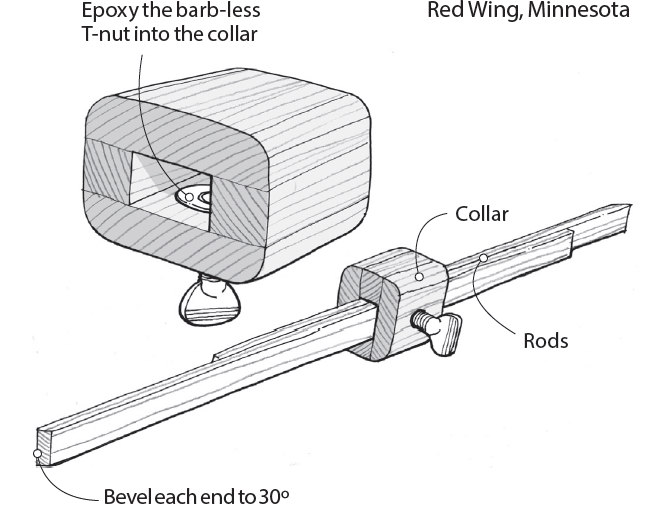We may receive a commission when you use our affiliate links. However, this does not impact our recommendations.

One of the most accurate approaches for checking a case or other assembly for square is to compare the inside diagonal measurements for equidistance. The easiest way to do this is using pinch rods – a pair of sticks clamped together with a collar to create the appropriate length for measuring. To use pinch rods, simply slide them apart until the ends slip inside two opposing case corners, then lock them together to check the opposite diagonals. I make pinch rods in various lengths to suit different-sized projects. For rods longer than 24″, I use two collars, clamping one at each end of the overlapping rods.
I make my pinch rods by ripping 3⁄16” strips from 3⁄4“-thick hardwood, beveling one end of each to about 30°. I make the collar by gluing together 1⁄2“-thick hardwood pieces as shown. The collar is 1 3⁄4“-wide by 1 3⁄4“-long, with a 1⁄2” x 2 5⁄32“-wide tunnel for the rods. The 1⁄2” dimension accommodates the two rods plus the head of a T-nut that holds a 5⁄16“-diameter x 1”-long clamping thumbscrew. I install the barb-less T-nut before assembling the collar, epoxying it in place from the inside face of the collar. After gluing the collar together, I round its edges for comfort, using a 3⁄8“-roundover bit in my router table. (For safety, hold the piece with a wooden handscrew clamp while routing.) –Pete Dulak
Here are some supplies and tools we find essential in our everyday work around the shop. We may receive a commission from sales referred by our links; however, we have carefully selected these products for their usefulness and quality.









I fully agree with the commentator above. Perhaps we didn’t understand what you meant. But based on logic, everything should be exactly as the previous commentator said. I used to even do research on this topic. Asked professional writers https://www.a-writer.com/professional-college-essay-writers/ for research on this topic. I can send it to the post office if interested.
Your article on shopmade pinch rods is interesting but a little misleading. Checking the diagonals of a four sided polygon does not indicate squareness at all.
An isosceles trapezoid (a four sided polygon)has equal diagonals and does not have a square corner.
In addition to checking diagonals one must also check opposite side dimensions. Opposite sides should be equal.